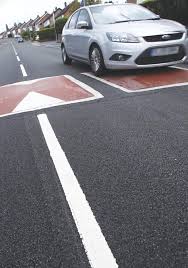
Rubber speed cushions, also known as traffic calming cushions or speed humps, have gained popularity as an effective tool for managing traffic speeds and enhancing road safety. In this article, we will delve into what rubber speed cushions are, their various types, how to choose the best speed cushion, and the reasons why they are considered a valuable addition to traffic management strategies.
What Are Rubber Speed Cushions?
Rubber speed cushions are traffic management devices designed to reduce vehicle speeds in specific areas, such as residential neighborhoods, school zones, and parking lots. These cushions are typically made of rubber or composite materials and are placed on the roadway’s surface in a pattern that forces vehicles to slow down while traversing them. They are wider than traditional speed bumps and have a gradual, raised profile with gaps in between, allowing larger vehicles, such as emergency vehicles and buses, to pass through more comfortably.
Types of Rubber Speed Cushions
- Rubber Speed Cushions: Traditional rubber speed cushions are constructed from high-quality rubber or recycled rubber materials. They offer excellent durability, resistance to weather conditions, and a noticeable reduction in vehicle speeds.
- Composite Speed Cushions: Composite speed cushions are made from a combination of materials, often incorporating rubber and plastic elements. These cushions are lightweight, easy to install, and provide effective traffic calming without sacrificing durability.
- Modular Speed Cushions: Modular speed cushions are designed as interlocking sections, allowing for flexibility in installation and removal as needed. This design can be especially useful for temporary traffic management in construction zones or during events.
Why Are Rubber Speed Cushions Useful?
- Traffic Speed Reduction: The primary purpose of rubber speed cushions is to slow down vehicles. By introducing a physical obstacle that forces drivers to reduce their speed, these cushions help improve road safety in areas with high pedestrian traffic, such as residential neighborhoods and school zones.
- Reduced Noise and Vibration: Rubber speed cushions generate less noise and vibration compared to traditional asphalt speed bumps, making them a preferred choice for residential areas. This minimizes disturbances to residents while still achieving the desired traffic calming effect.
- Emergency Vehicle Access: Unlike conventional speed bumps, rubber speed cushions are designed to accommodate emergency vehicles, public transportation, and larger vehicles like buses and delivery trucks. The gaps between the cushions allow these vehicles to pass over them without significant discomfort or disruption.
- Improved Driver Compliance: Rubber speed cushions are more effective at encouraging driver compliance with speed limits compared to signs alone. Their physical presence serves as a visual and tactile reminder to slow down, reducing the need for aggressive enforcement measures.
- Enhanced Pedestrian Safety: By slowing down vehicles, rubber speed cushions enhance pedestrian safety in crosswalks and school zones. They create a safer environment for pedestrians to cross the road, reducing the risk of accidents and injuries.
- Customizable Solutions: Rubber speed cushions come in various sizes and configurations, allowing traffic engineers and municipalities to tailor their use to specific road conditions and traffic management needs. This flexibility makes them a versatile tool for traffic calming.
- Cost-Effective Traffic Management: Rubber speed cushions are cost-effective traffic management solutions when compared to more extensive infrastructure changes like road widening or traffic signal installation. They can be quickly deployed and are easy to maintain.
Conclusion
Rubber speed cushions have emerged as an effective and versatile traffic management tool that combines the benefits of reduced vehicle speeds, improved road safety, and minimal disruption to emergency vehicles and local residents. As communities continue to prioritize road safety and traffic management, rubber speed cushions are likely to remain a valuable asset for municipalities and traffic engineers in their efforts to create safer and more livable urban environments.